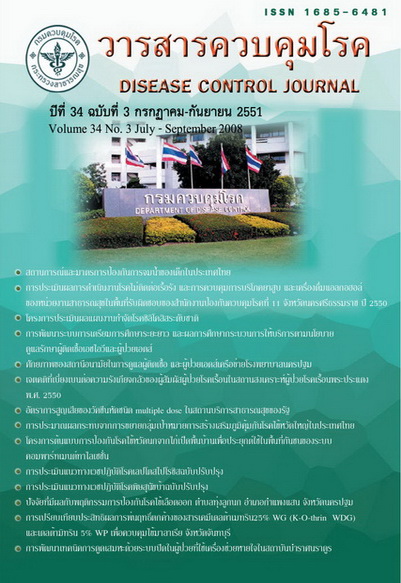Development of Closed System Suction Technique in Patient with Mechanical Ventilator in Bamrasnaradura
Keywords:
Close System Suction, Ventilator Associated PneumoniaAbstract
This Quasi experimental research prospective study was conduted during October 2005- October 2007. The inclusion criteria were: surgical and medical patients older than 13 years, undergoing mechanical ventilator (MV) for more than 48 hours in ICU at Bamaranadura Infectious Disease Institute. Patients were randomized into two groups: one group was suctioned with Closed System Suction (CSS), and another group with Open System Suction (OSS). Ventilator Associated Pneumonia (VAP) was defined according to the following criteria: CDC guideline for VAP surveillance. The O2 saturation was evaluated before suctioning, then at the first, fifth and tenth minute after suctioning. The instrument in this study consisted of three parts. The first part was the guideline of endotracheal tube suctioning both CSS and OSS, and the guideline for VAP surveillance. The second part was the record of patient's duration, the incidence of VAP, the O2 saturation. The third part was the investigator equipment record. Data were analyzed by using frequency, mean, Chi-Square Test, and Mann - Whitney U Test. Among the 38 patients having Open System Suction 11 developed VAP while of the 38 patients undergoing Closed System Suction, nine developed infection (P = 0.79). and O2 saturation after suctioning 1, 5 and 10 minutes. However, loss of O2 saturation in OSS tended to lower than in CSS. Although the CSS did not decrease the incidence of VAP when compared with the OSS. CSS should be the option to use in patients with severe or dangerous respiratory tract infection and order to prevent the risk of respiratory transmission to the health care personnel and also to prevent the spread of infection to the environment.
References
2. Ackerman, M.H. A review of normal saline instillation:implications for practice. Critical Care Nursing. 1996; 15: 31-38.
3. Blackwood, B. The practice and perception of intensive care staff using the closed suctioning system. Journal of Advanced Nursing. 1998; 28 : 1020-1029.
4. Bostick, J. and Wedelgass, ST. Normal saline instillation as part of the suctioning procedure. Heart&Lung. 1987; 16: 532-537.
5. เสาวลักษณ์ จิรธรรมคุณ. การศึกษาเปรียบเทียบผลการดูดเสมหะ ระหว่างการหยอดและการไม่หยอดน้ำเกลือนอร์มัลในท่อหลอดลมคอ ต่ออัตราการเต้นของหัวใจ ความดันโลหิตซีสโตลิก ค่าความอิ่มตัวของออกซิเจนในโลหิตแดงและความเหนียวสัมพันธ์ของเสมหะในผู้ป่วยหลังผ่าตัดหัวใจแบบเปิดที่ใช้เครื่องช่วยหายใจ. ปริญญาพยาบาลศาสตรมหาบัณฑิต สาขาพยาบาลศาสตร์ มหาวิทยาลัยมหิดล, 2534.
6. Suctioning. A lung model evaluation of suctioning systems. online available to: http://ccforum.com/paperreport/ccf, 7 July, 2006
7. สมหวัง ด่านชัยวิจิตร และคณะ.โรคติดเชื้อในโรงพยาบาลในประเทศไทย พ.ศ. 2549. กรุงเทพฯ: โรงพิมพ์ชุมชนสหกรณ์การเกษตรแห่งประเทศไทย จำกัด, 2549
8. Danchaivijitr, S., Tangtrakool, T. and Chokloikaew, S. The second Thai national prevalence study on Nosocomial Infections 1992. Journal of the Medical Association of Thailand. 1995; 78: 67-71.
9. Danchaivijitr, S., et al. Nosocomial infection in Thailand 1998. Presentation at the 12th Workshop on Nosocomial Infection Control, Pailyn hotel Sukhotha. Thailand: Nosocomial infection in Thailand, 1998
10. ลักษณา ชุติชีวานันท์. โรคติดเชื้อในหอผู้ป่วยหนัก กุมารเวชกรรม โรงพยาบาลพระปกเกล้าจันทบุรี. วารสารศูนย์การศึกษาแพทย์ศาสตร์คลินิก โรงพยาบาลพระปกเกล้า. 2538; 12: 231-238.
11. คณะอนุกรรมการป้องกันและควบคุมโรคติดเชื้อในโรงพยาบาล ฝ่ายการพยาบาล โรงพยาบาลมหาราชนครเชียงใหม่. ผลสำรวจอัตราชุกของโรคติดเชื้อในโรงพยาบาล โรงพยาบาลมหาราชนครเชียงใหม่. เชียงใหม่: ฝ่ายการพยาบาล โรงพยาบาลมหาราชนครเชียงใหม่, 2541.
12. คณะกรรมการป้องกันและควบคุมโรคติดเชื้อในโรงพยาบาล ฝ่ายการพยาบาล สถาบัน บำราศนราดูร. ผลสำรวจอัตราชุกของโรคติดเชื้อในโรงพยาบาล สถาบันบำราศนราดูร. นนทบุรี: ฝ่ายการพยาบาล สถาบันบำราศนราดูร, 2548.
13. คณะกรรมการป้องกันและควบคุมโรค ติดเชื้อในโรงพยาบาล ฝ่ายการพยาบาล สถาบันบำราศนราดูร. ผลสำรวจอัตราชุกของโรคติดเชื้อในโรงพยาบาล สถาบันบำราศนราดูร. นนทบุรี: ฝ่ายการพยาบาล สถาบันบำราศนราดูร, 2549.
14. วราภรณ์ เทียนทอง. ผลของการใช้เทคนิคการดูดเสมหะด้วยระบบปิดต่อการเกิดปอดอักเสบจากการใช้เครื่องช่วยหายใจและความอิ่มตัวของออกซิเจนในเลือดแดงในผู้ป่วยที่ใช้เครื่องช่วยหายใจ วิทยานิพนธ์ปริญญาพยาบาลศาสตร์มหาบัณฑิต, สาขาวิชาการพยาบาลผู้ใหญ่, มหาวิทยาลัยรังสิต, 2550.
15. Carlon GC, Fox SJ. and Ackerman NJ. Evaluation of closed-tracheal suction system. Critical Care Medicine. 1987: 15: 522-538.
16. Craig K, Benson M. and Pierson D. Prevention of arterial oxygen desaturation closed airway endotracheal suction effect of ventrilation mode. Respiratory care. 1991; 29: 1013-1018.
17. Cobley M, Atkins M. and Johnes PL. Environmental contamination during tracheal suction: a comparison of disposable conventional catheters with a multiple-use closed system device. Anaesthesia. 1991; 46: 957-961.
18. Deppe, S.A., et al. Incedence of colonization, nosocomail pneumonia and mortality in critically ill patients using a Trach Care closed- suction system versus an open-suction system: prospective randomized study. Critical Care Medicine. 1990; 18: 1389-93.
19. Silva, L.D. A infecious pumonar no contexto da tecnica de aspiracao endotraqueal: avaliacao da Implantacao de ummodelo padrao em um progama de educacao continuada. Master degree Dissertation, Escola de Enfermagem, Universidade de Sao Paulo, 1998.
20. Zeitoun, S.S., de Barros, A.L. and Diccini, S. A prospective, randomized study of ventilator – associated pneumonia in atients using a closed versus open tracheal system. Clinical Nursing. 2003; 12: 484-489.
21. Lorente, L., Lecuona, M., Martin, M.M., Garcia,C., Mora, M.L. and Sierra, A. Ventilator – associated Pneumonia using a closed versus an open tracheal suction system. Critical Care Medicine. 2005; 33: 115-119.
22. Jorgerden, I.P., Rovers, M.M., Grypdonck, M.H., Bonten, and Marc, J. Open and Closed Endotracheal Suction Systems in Mechanically Ventilated Intensive Care Patients: A Meta-Analysis. Critical Care Medicine. 2007; 35: 260-270.
23. Eun - Sook, L., Sung - Hyo, K. and Jung - Sook, K. Effects of Closed Endotracheal Suction System on Oxygen Saturation, Ventilator - Associated Pneumonia, and Nursing Efficacy. Korean Society of Nursing Science. 2004: 1315-1320.
24. Danchaivijitr, S., Dhiraputra, C., Santiprasitkul, S. and Judaeng, T. Prevalence and impacts of nosocomial infection in Thailand 2001. Journal of the Medical Association of Thailand. 2005; 88: 1-9.
25. The committee for The Japanese Respiratory Society guidelines in management of respiratory infections. Ventilator - Associated Pneumonia. The Japanese Respiratory Society. 2004; 9: 30 - 34.
26. Kollef, M. Prevantion of hospital - associated pneumonia and ventilator - associated pneumonia. Critical Care Medicin. 2004;32: 1396-1405.
27. American Thoracic Society and the Infectious Diseases Society of America. ATS/IDSA Guidelines: Guidelines for the management of adults with HAP, VAP, and HCAP. American Journal Respiratory Critical Care Medicine. 2005; 171: 388
28. Crimslisk J, Paris R, Mcgonagle E. and Farber H. The Closed tracheal suction system: implications for critical care nursing. Dimens Critical Nursing. 1994; 13: 292-388.
29. Lasocki, S., Lu, Q., Sartorius, A., Fouillat, D., Remerand, F. and Rouby, J.J. Open and closed - circuit endotracheal suctioning acute lung injury : efficiency and effects on gas exchange. Anesthesiology. 2006; 104: 39 - 47.
Downloads
Published
How to Cite
Issue
Section
License
Articles published in the Disease Control Journal are considered as academic work, research or analysis of the personal opinion of the authors, not the opinion of the Thailand Department of Disease Control or editorial team. The authors must be responsible for their articles.



.png)



